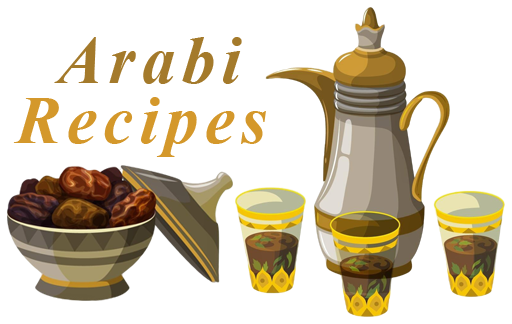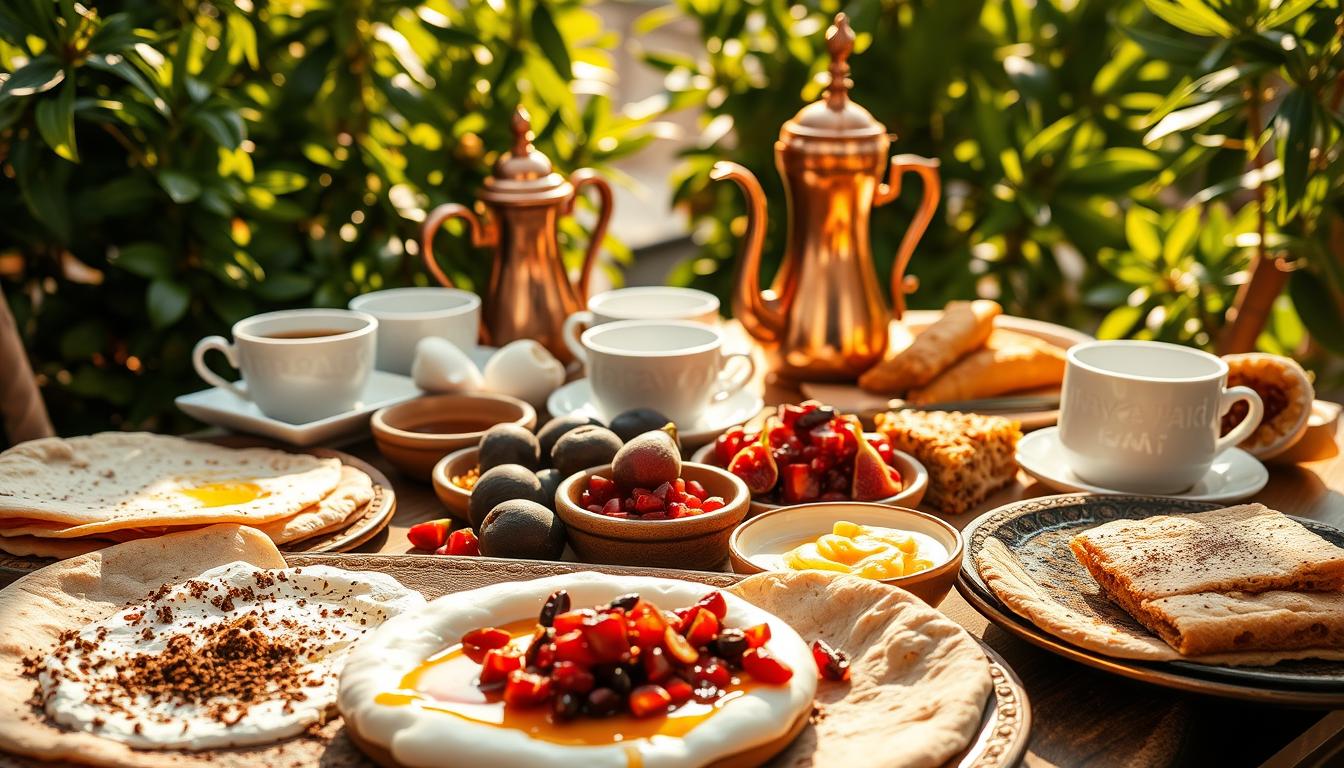Enjoy Delicious Arabic Breakfast Ideas Every Morning
Imagine sitting around a table with lots of colorful dishes. The smell of fresh bread fills the air, and everyone feels welcome. This is what a traditional Middle Eastern breakfast is all about.
It’s a moment to bond with loved ones, sharing food and enjoying each other’s company. The use of fresh ingredients and different textures makes it stand out. As you dive into the world of Arabic breakfast, you’ll find a mix of flavors and traditions that show true hospitality.
This guide will show you the tasty and varied world of Arabic breakfast. We’ll explore its cultural importance and the dishes that make it unique.
The Essence of Arabic Breakfast Culture
Explore the heart of Arabic breakfast culture, where flavors and hospitality come together. Arabic breakfasts are a key part of daily life. They bring families and friends together with a table full of tasty dishes.

Unique Ingredients and Flavors
Arabic breakfasts include olive oil, yogurt, za’atar, butter, mixed cheese platter, mixed vegetables, jam, and warm bread. This mix creates a delicious and healthy meal. The use of fresh ingredients and aromatic spices is key to the Arabic breakfast.
The focus on fresh produce, dairy, and baked goods is not just about filling your belly. It’s also about starting your day right. Za’atar and olive oil add a unique flavor that’s both traditional and welcoming.
Traditional vs. Modern Interpretations
Traditional Arabic breakfasts are loved, but modern twists are also becoming popular. You can see the evolution of Arabic breakfast with new ingredients and cooking methods alongside the classics.
For example, dishes like ful medames and shakshuka are getting a modern makeover. They’re being mixed with unique spices or served with different breads. This mix of old and new keeps the cuisine fresh and exciting.
Popular Arabic Breakfast Dishes
Arabic breakfast dishes showcase the rich culinary heritage of the Arabic world. They combine traditional flavors with nutritional value. These dishes are not only tasty but also highlight the cultural diversity of the region.
Ful Medames: The Protein-Packed Favorite
Ful Medames is a classic Arabic breakfast dish. It’s made from fava beans, garlic, lemon, and cumin. This protein-packed favorite is a filling start to the day.
To prepare Ful Medames, you need:
- Fava beans
- Garlic
- Lemon juice
- Cumin
- Olive oil
Cook the fava beans with garlic, then add lemon juice and cumin. Serve with olive oil and fresh bread for a satisfying breakfast.

Shakshuka: A Spicy Egg Delight
Shakshuka is a beloved dish in Middle Eastern and North African cuisine. It’s a flavorful and nutritious option for breakfast. Eggs are cooked in a rich tomato sauce with spices.
Shakshuka is versatile. You can adjust the spiciness and add ingredients like bell peppers or onions.
Labneh: Creamy Delight with Fresh Bread
Labneh is a creamy yogurt-based cheese. It’s a staple in Arabic breakfast. It’s often served with fresh bread, olive oil, and herbs.
Labneh is great on its own or with other dishes like Ful Medames or Shakshuka. It’s also perfect for toppings like honey or za’atar.
Adding these Arabic breakfast dishes to your routine can bring variety and nutrition. Whether it’s Ful Medames, Shakshuka, or Labneh, you’ll enjoy the rich flavors and cultural heritage they offer.
Bread Varieties in Arabic Breakfast
Bread is a key part of Arabic breakfast, with many textures and flavors. It lets you taste the rich history of the Middle East.
Bread is essential in Arabic breakfast. It ranges from soft pita to cheesy Manakish. Each bread adds its own special touch.

The Role of Pita Bread
Pita bread is a must-have in Arabic breakfast. It’s great for scooping dips or wrapping fillings. Making pita at home is easy with flour, water, yeast, salt, and olive oil.
To make real pita, follow these steps:
- Mix the dough ingredients and knead until smooth.
- Let the dough rise until it doubles in size.
- Divide the dough into small balls and roll them out into thin circles.
- Bake the pita in a hot oven until it puffs up.
Manakish: The Flavorful Flatbread
Manakish is like the “pizza of the Middle East.” It’s topped with zaatar, cheese, and minced meat. You can pick your favorite toppings for a tasty breakfast.
Some top Manakish toppings are:
- Zaatar with olive oil.
- Melted cheese, often mixed with zaatar or herbs.
- Minced lamb or beef, cooked with onions and spices.
Adding these breads to your Arabic breakfast makes it both filling and tasty. Whether you prefer classic pita or adventurous Manakish, there’s a bread for you.
Healthy Arabic Breakfast Options
You can make your Arabic breakfast both nutritious and tasty with a few easy choices. Adding fresh veggies and whole grains boosts your meal’s health benefits.
Incorporating Fresh Vegetables
Fresh veggies are key in many Arabic breakfasts. They add taste, texture, and lots of nutrients. Tomatoes, cucumbers, and bell peppers are favorites in dishes like shakshuka and salads.
Nutritional Benefits: Fresh veggies are full of vitamins, minerals, and antioxidants. They give you energy and support your health.
- Tomatoes are full of vitamin C and lycopene, an antioxidant that fights off diseases.
- Cucumbers are hydrating and rich in vitamin K, important for strong bones.
- Bell peppers are loaded with vitamin C and antioxidants that fight inflammation.
Whole Grains in Arabic Breakfast
Whole grains are also vital for a healthy Arabic breakfast. They offer fiber, which aids digestion and keeps you full. Whole wheat bread and brown rice are great choices.
| Whole Grain | Nutritional Benefits |
|---|---|
| Whole Wheat Bread | Rich in fiber, vitamins, and minerals. Helps with digestion and keeps you full. |
| Brown Rice | High in fiber and manganese, a mineral that supports bone health and metabolism. |
| Oats | Rich in fiber and various nutrients. Can help lower cholesterol levels and improve heart health. |
Adding whole grains to your Arabic breakfast makes it more balanced and filling. Try whole wheat bread with olive oil, za’atar, and fresh veggies for a healthy start.
The Importance of Spices
In Arabic cuisine, spices are more than just flavor enhancers. They are the heart of breakfast, turning it into a special moment. You might know the smell of cumin or the taste of coriander. But in Arabic breakfast, these spices are key to the culture.
Arabic breakfasts are known for their spice blends. These spices add a burst of flavor to every meal. Experts say Middle Eastern dishes use spices like cumin, coriander, and za’atar. These are key to the taste of ful medames and shakshuka.
Common Spices Used in Breakfast Dishes
Spices in Arabic breakfast are both an art and a tradition. Here are some common ones:
- Cumin: Adds warmth and depth to dishes like ful medames.
- Coriander: Gives a sweet and citrusy taste, often paired with cumin.
- Za’atar: A mix of herbs like thyme, oregano, and marjoram, with sumac and sesame seeds. It adds a tangy flavor to flatbreads.
How Spices Enhance Flavor Profiles
Spices do more than add flavor; they make the meal better. By using different spices, Arabic breakfasts become complex and satisfying. For example, sumac adds a tangy taste that goes well with rich dishes like labneh.
Adding these spices to your breakfast is more than just eating. It’s experiencing a culture rich in tradition and hospitality. Using spices like cumin and coriander can make your middle eastern brunch unforgettable.
Pairing Beverages with Arabic Breakfast
The rich flavors of Arabic breakfast dishes are often complemented by a selection of traditional and refreshing beverages. You can enhance your dining experience by pairing the right drinks with your meal.
Traditional Drinks: Mint Tea and Arabic Coffee
Traditional Arabic breakfasts are often accompanied by Mint Tea and Arabic Coffee. Mint Tea is a fragrant, sweetened tea infused with fresh mint leaves. It provides a refreshing contrast to the rich flavors of breakfast dishes. Arabic Coffee, on the other hand, is strong and aromatic. It’s often flavored with cardamom, adding a unique spice to your meal.
Here are some key characteristics of these traditional drinks:
- Mint Tea: Refreshing, sweet, and fragrant
- Arabic Coffee: Strong, aromatic, and spicy
Refreshing Juices and Smoothies
In addition to traditional drinks, refreshing juices and smoothies are also popular choices to pair with Arabic breakfast. Options like orange juice, made from freshly squeezed oranges, or a yogurt-based smoothie with fruits and nuts, can provide a delightful contrast to the savory flavors of the meal.
Some popular refreshing beverages include:
- Orange Juice: Freshly squeezed and vitamin-rich
- Yogurt Smoothie: Creamy, fruity, and nutritious
- Mango Juice: Sweet and refreshing
By choosing the right beverage to pair with your Arabic breakfast, you can elevate the dining experience and enjoy a more balanced and satisfying meal.
Breakfast Customs and Traditions
The morning meal in Arabic culture is a cherished moment. It’s a time for family and friends to gather. They share stories and strengthen bonds over delicious food.
Gathering Around the Table
In many Arabic households, breakfast is a communal experience. Family members and guests gather around the table. They share a variety of dishes.
Sharing food is key to Arabic breakfast traditions. Dishes like ful medames, shakshuka, and labneh are placed in the center. This allows everyone to help themselves. It symbolizes hospitality and generosity.
The Role of Hospitality in Breakfast
Hospitality is a big part of Arabic breakfast customs. Hosting breakfast for guests shows respect and generosity. The effort in preparing dishes shows the host’s warmth.
A traditional Arabic breakfast spread has many dishes, from savory to sweet. This variety ensures everyone finds something they like. It makes the meal enjoyable for all.
| Custom | Description | Significance |
|---|---|---|
| Gathering Around the Table | Family and friends come together to share a meal. | Fosters a sense of community and togetherness. |
| Sharing Food | Dishes are placed in the center for everyone to share. | Symbolizes hospitality and generosity. |
| Hospitality | Hosting breakfast for guests is a sign of respect. | Reflects the host’s warmth and welcoming nature. |
By understanding and embracing these customs, you can create a meaningful Arabic breakfast at home. Whether hosting family or friends, focusing on gathering and hospitality makes breakfast gatherings more enjoyable and memorable.
Vegetarian and Vegan Arabic Breakfast Choices
Arabic breakfast offers many plant-based dishes that are both healthy and tasty. You can try different flavors and textures, like fresh salads and hearty eggplant dishes.
Tasty Tabbouleh and Fattoush Salads
Tabbouleh and Fattoush are two favorite salads in Arabic breakfast. Tabbouleh is a cool salad with bulgur, parsley, tomatoes, mint, and onions. It’s dressed with olive oil and lemon juice. Fattoush is a toasted bread salad with mixed greens, radishes, and feta cheese (which can be left out for a vegan version).
To make vegan Tabbouleh, just skip the animal products and use fresh, quality ingredients. For vegan Fattoush, swap the feta with a plant-based option or add more veggies like roasted eggplant or chickpeas.
Eggplant Dishes for Plant-Based Eaters
Eggplant is a key ingredient in Arabic cooking, perfect for plant-based breakfasts. You can enjoy it as mashed eggplant with garlic and lemon, or in a rich stew with chickpeas and spices.
- Mash roasted eggplant with tahini, garlic, and lemon juice for a creamy dip.
- Sauté sliced eggplant with onions, bell peppers, and tomatoes for a flavorful breakfast skillet.
- Layer sliced eggplant with tomato sauce and vegan cheese for a plant-based moussaka.
These eggplant dishes are great for vegans and highlight the variety of Arabic breakfast. By using spices and fresh ingredients, you can make a healthy and tasty Middle Eastern brunch for everyone.
Serving Arabic Breakfast at Home
Start your day with the rich flavors of an Arabic breakfast. Serving it at home is a fun way to share culture and traditions. It’s important to arrange dishes nicely and encourage everyone to share.
Creating a Breakfast Spread
To make a real Arabic breakfast spread, you need a variety of dishes. Start with Ful Medames, a fava bean dish, and Shakshuka, a spicy egg dish. Add cheeses, olives, and fresh veggies to go with your main dishes.
Remember to include Manakish, a tasty flatbread with olive oil, za’atar, or cheese. The goal is to have a mix of flavors and textures, making it feel like a feast.
Essential Equipment for Preparing Dishes
For an Arabic breakfast, you need some key tools. A non-stick skillet is great for Shakshuka. You’ll also need a large serving platter to display your spread.
- A coffee grinder for freshly grinding coffee beans for Arabic coffee
- A mortar and pestle for preparing spice blends
- A cast-iron pan for cooking flatbreads like Manakish
Having the right tools makes cooking easier and more fun. It lets you enjoy the act of hosting.
Conclusion: Exploring Arabic Breakfast at Your Own Table
Now you know about the rich flavors and traditions of Arabic breakfast. It’s time to bring them into your home. Trying new recipes is a great way to start your day with a tasty and healthy meal.
New Flavors to Try
Start by trying different ingredients and spices to make unique Arabic breakfast dishes. You could make Ful Medames, a protein-rich favorite, or Shakshuka, a spicy egg dish. Feel free to change recipes to fit your taste, using fresh veggies and whole grains.
Adapting to Your Taste
The first step is to try something new and move away from the usual. Try adding traditional drinks like mint tea and Arabic coffee to your morning. Or, try refreshing juices and smoothies. By exploring these new flavors and recipes, you can create a breakfast that’s both tasty and true to its roots.

